
|   |

|   |
Seminar on Guru Shishya Parampara at Mulam Festival - Apoorva Sameer Rao e-mail: artappu@gmail.com August 22, 2016 "Guru Brahma Guru Vishnuhu Guru Devo Maheshwaraha Guruh sakshath parambrahma thasmaiy Sri gurave namaha." Guru Shishya Parampara has been the most ancient system of learning in India and is also known as the best. From the times of Veda, education has been given by the guru orally which is known as Guru-mukhi. The student while living in a Gurukul would offer services to the guru and at the same time, living under a stringent discipline, spending moderate lifestyle and perpetually practicing whatever education has been given to the student by the guru and learning by heart was the only way to receive knowledge. The modern day practices have however made this system institutional. Perhaps the changing interests from generations and influence of foreign educational systems could be the reasons behind this alter. In assent to this outlook, ‘Mulam - Remembering our Gurus’, a national seminar and dance festival took place at Natana Rangashaale on the 30th and 31st of July in Mysore. It was organized by Kuchipudi dancer Vyjayanthi Kashi’s Shambhavi School of Dance in association with Natana School of Theatre Arts run by theatre personality and Kannada actor Mandya Ramesh. 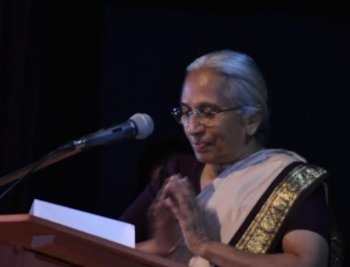 Nandini Eshwar
The second day of the festival commenced with seminar on the subject of Guru Shishya Parampara. The seminar was inaugurated by chairperson of the session, Nandini Eshwar of Raasavrunda School of Dance, Mysore, with a brief introductory speech. Ranjana Gauhar spoke about the significance of a guru and a shishya, the value of their relationship, then and now. She upheld the traditional importance where a guru holds lamp to show the right path of truth and discipline. A shishya can be a true one only if he/she comes with an entire emptiness to receive whatever is bestowed upon them. But in the contemporary period, the students are not as disciplined and naïve as they were earlier since they are prejudiced about knowledge due to development in the use of technology. They seemed to have already learnt quite a bit before approaching their desired guru. She pointed out that the problems such as influence and involvement of parents in the learning process of a student and few teachers who struggle to nurture only the rich ones which, in a way, hinder retainment of significance of the tradition. When she was asked as to which was her most unforgettable memory with her guru, she recollected her days as a student when she used to plead with her guru to give just one hour of his precious time in teaching which she would convert into 8 hours of practice. She concluded her talk by quoting “The fulfillment of guru-shishya parampara is achieved only when the guru and shishya burn together as two wicks of the same lamp.” 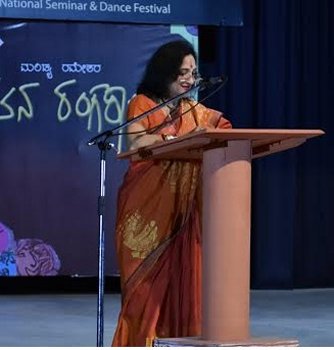 Ranjana Gauhar 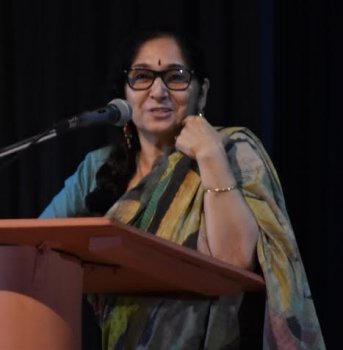 Uma Dogra Uma Dogra, the ganda bandh shahgirdh (formally initiated disciple; Ganda-bandh is a traditional knot-tying-ceremony which cements the relationship between guru and student) of legendary Kathak exponent Pandit Durga Lal, mostly recollected her days being a student herself as an example for the proper gurukula system of learning. She learnt the basic realities of life and not just the lessons related to art from her guru. Every moment spent with the guru is always a learning experience. She remembered her guru who always said, “When on stage be the master of that stage. When off stage be the ultimate learner no matter who you are in reality and this is the genuine meaning of guru and shishya and one is led to salvation when this relation is understood accurately.” Prof. Shridhar of Fine Arts College of Mysore University spoke about his field of expertise which is music. He explained that “Tradition is the only course which allows the stream of knowledge to flow.” Vedas, wisdom, spirituality, artistic culture are primary aspects which bring about effectiveness of existence. Epics like Ramayana and Mahabharatha have prominently depicted the bonding between guru and shishya. The shishya is in constant search for the root of ‘Guru parampara’. A guru is constantly providing education and leading the shishya into the ocean of self knowledge or Athmajnana. He said that there is no music without dance and no dance without music and hence quoted that in music, musical notes dance too. The compositions of the trimurtis of Carnatic classical music - Saint Thyagaraja, Shyama Shastri and Muthuswami Dikshitar - and Saint Purandaradasa and alike are preserved till today only because they were passed on to their disciples from generation to generation. This signifies, very precisely, the prominence of guru-shishya parampara in our country. In today’s tradition if the principle of guru is understood properly, there is a small hope of keeping this tradition alive. But in universities, the semester schemes applied in learning classical art forms are obstructing the preservation of this age old tradition. He concluded that instead of finding different and effortless ways of devotion and spirituality, one should concentrate on searching the source of them all and henceforth strengthening the root itself. And for this purpose to be accomplished, guru and shishya should come as one. 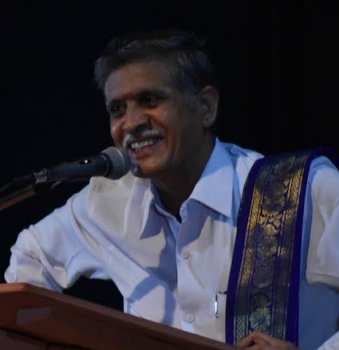 Prof. Shridhar 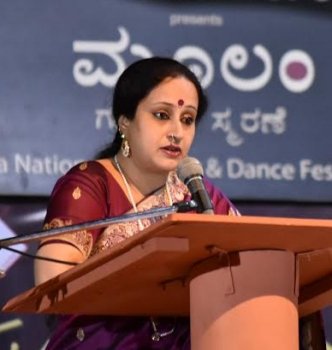 Dr. Anupama Kylash Vilasini Natyam exponent Dr. Anupama Kylash, spoke vastly about three types of gurus - Adiguru are parents, Shiksha Guru is one who imparts knowledge and Deekshaguru is one who provides salvation. She stated that the primary guru is within one’s self which we are supposed to discover. And the one helping us in this discovery is the ultimate guru. She explained institutionalized system of learning Indian art forms where the quest of study is already furnished and hence reducing the possibilities of facing challenges in the process of learning and in life as well. She had an impressive and distinctive point of view about the guru and shishya. She says only when the senior students of a certain guru teach their younger ones, who are also being trained under the same guru, they will have self-realization. And to monitor this there is the ultimate guru. A guru’s surrounding also influences the learning process of the students. She recollected the type of teaching from the past where transmission of subjects used to happen orally and how strongly it would build one’s memory power, enough to last a lifetime. In contrast, she briefed about the problems in the universities while imparting training in classical art forms, both of which she compared to the famous ‘Markata-Marjala Nyaya’ where the mother monkey Markata moves around carefree and it is the duty of the baby monkey to hold itself tightly to the mother and where a cat Marjala holds on to the kitten firmly enough not to drop it and gently enough not to hurt it. Well known theatre person Atul Tiwari started off with a very interesting story where a rickshaw puller from Bengal, who has an immense urge to read, found a book and started reading but came across a word which he could not relate with any known words. The word was “jijibishaa.” To know the answer to it one day he waited in front of a university from where arrives a learned lady. He asks the lady to tell him the meaning of the word “jijibishaa”. The lady was taken by surprise but later told him the meaning was “a strong will to live.” After telling him the meaning, she gives him her address and orders him to write a story and post it to her and went away. The rickshawala was baffled when he discovered that the lady was none other than the author of the novel he was reading, Mahashweta Devi, author of ‘Agnigarbh.’ Atul Tiwari reckoned that this is a teacher who made the rickshawala live the word, the meaning of which he was strongly searching an answer for. He indicated that nowhere else in the world is the relationship between a student and a teacher as prominent as it is in India. For example, he mentioned that in the universities of China, a teacher’s job is only to teach. He is not supposed to be questioned nor will he answer anybody who questions him. The students should search for answers on their own. He mentioned the magnitude of teaching and learning with respect to each other, quoting the example of shadow puppet play from Indonesia. A puppeteer starts training as early as age six. He is trained rigorously to have a muscle memory. Singing, education of music, mask making etc. are taught for as long as 18 years, only to stand behind a curtain and perform. Such is the intensity of training and such is the dedication of learning. Finally, he pointed out that to bring out the best not just one guru is enough but requirement of multiple gurus is necessary which is also quite prevalent in modern day scenario. 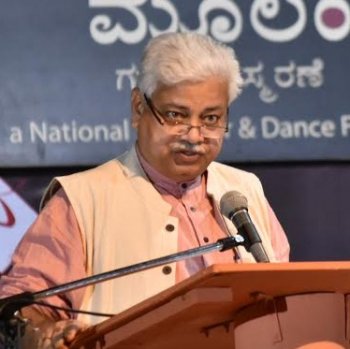 Atul Tiwari 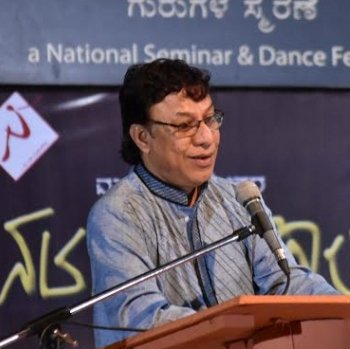 Santhosh Kumar Chatterji Santhosh Kumar Chatterji, a Kathak exponent of Lucknow gharana, spoke vastly about his personal encounters with his guru where he had to struggle all the way to his guru’s place and go through a tough decision making when he was asked by his guru in the process of learning, “You either make me yours or you become mine” to choose between the two by which he brought up a fact that a guru teaches to develop immense patience and perseverance, the two most basic essentials of a student’s life. He mentioned a very intriguing quote, “Guru karo jaan kar, paani peeyo chaan kar” which means, find a guru with thorough knowledge and drink water after testing it. He said that a guru should grant his knowledge completely to the disciple only then the age old traditions continue to linger. Lastly it was Roopashree Madhusudan, a Sanskrit Scholar and a Bharatanatyam dancer as well. She mostly spoke picking up the verses from Kathopanishad, Taittiriya Upanishad and Ishavasya Upanishad. In brief, she conveyed the conversation between the young Brahman lad Nachiketa and god of death, Yama, said in the Kathopanishad. Here, Yama plays the role of a teacher and Nachiketa the student. Nachiketa is taught self knowledge, the separation of human soul (supreme self) from the body. There were quotes bringing up the significance of guru and shishya in Dwaitha, Advaitha and Vishishtadhvaitha philosophies. A Sanskrit Subhashitha says “Guruseve yatha khanan khanitEna naro varyabhigachchathi, Evam gurugatham vidyam shushrusharyabhigachchathi” which means that the treasure of knowledge in a guru is gained only through pure guru seva and hence a student should keep digging the treasure of knowledge from the guru through guru seva, just like the process of digging deep inside the earth to acquire pure gold. The process of attaining eminence is divided into four quarters wherein first quarter is contributed by teachings of guru, second quarter is from study mates, third is through self-study and the fourth is through experience. She concluded the seminar with a meaningful thought and brilliant approach towards learning while highlighting the importance of guru shishya parampara. The wonderful thought filled seminar was wrapped up briefly by the chairperson of the seminar, Nandini Eshwar, and the scholars were honoured. At ‘Mulam-Remembering our Gurus,’ the rasikas got to hear assorted thoughts on the significance of the relation between guru and shishya that gave a deep insight in preserving the tradition. |